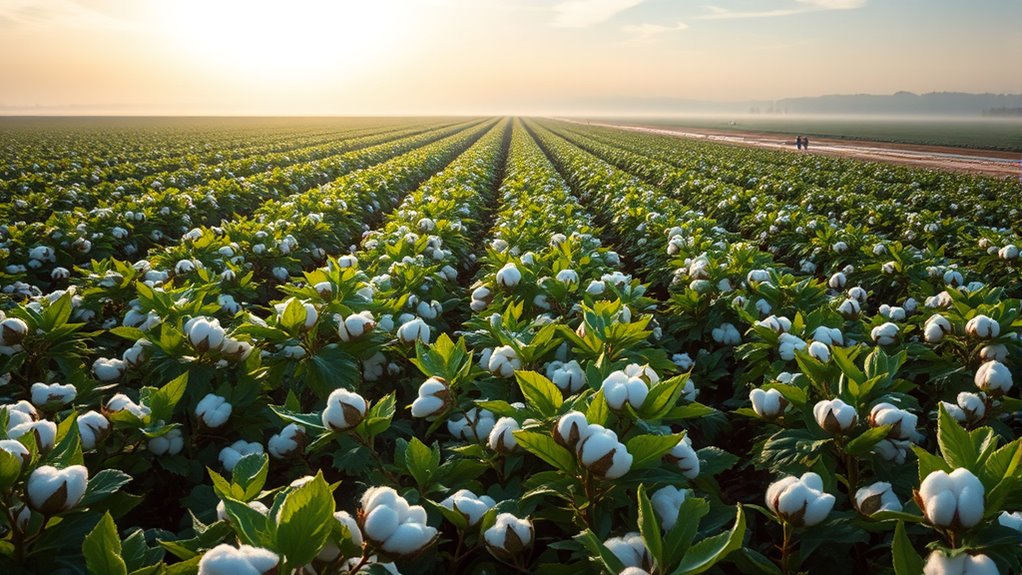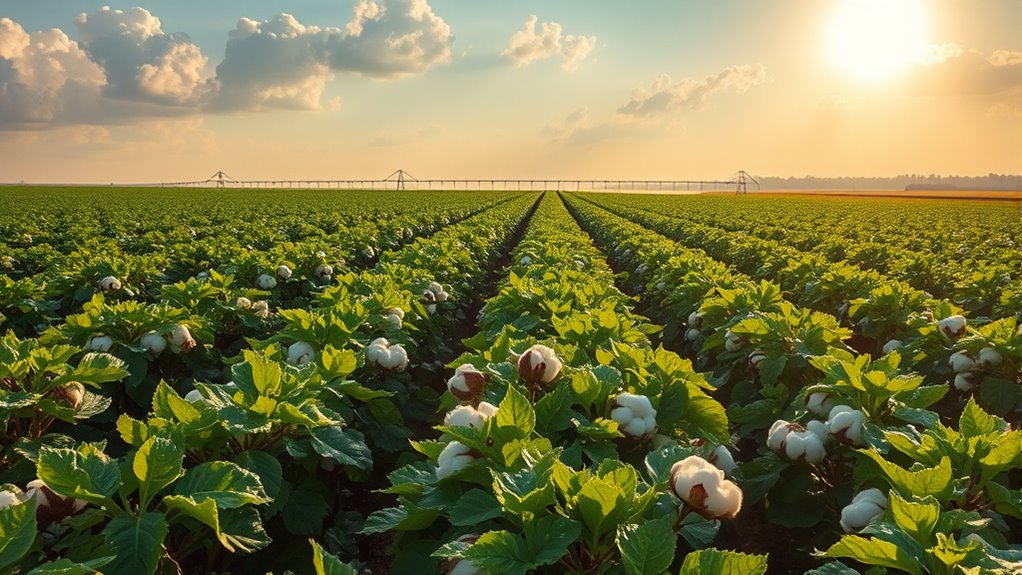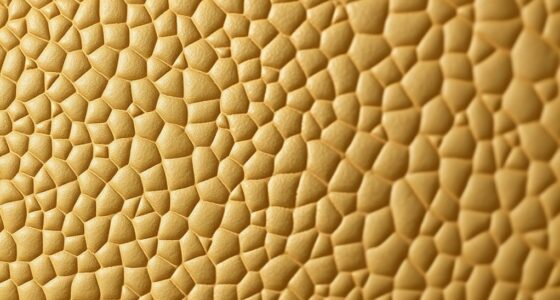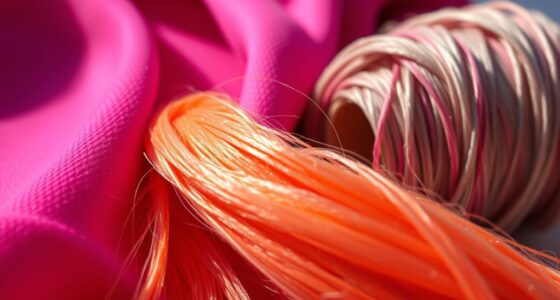Cotton needs a lot of water—about 2,700 liters per kilogram—due to traditional farming methods that rely heavily on irrigation, especially in water-scarce areas. Its cultivation can strain local water supplies, cause soil erosion, and impact ecosystems. However, sustainable practices like organic cotton, water-saving techniques, and innovative textiles are helping reduce its water footprint. To find out how the industry and you can make better choices, keep exploring the options available.
Key Takeaways
- Cotton requires about 2,700 liters of water per kilogram due to intensive irrigation and traditional farming methods.
- Its cultivation heavily depends on water-scarce regions, leading to overuse and environmental stress.
- Conventional cotton farming uses significant chemicals alongside water, increasing environmental degradation.
- Sustainable practices like organic farming and water-efficient technologies can reduce cotton’s water footprint.
- Consumer choices and industry innovations are vital for lowering water use in textile production.

Have you ever wondered how much water goes into making your favorite fabrics? It’s a surprising amount, especially when it comes to cotton, which is notorious for its high water footprint. As someone interested in sustainable fashion, you should know that the textile industry is taking steps to reduce its water consumption through sustainable textile practices. These practices aim to minimize water use by implementing innovative water conservation techniques, such as recycling wastewater, optimizing irrigation, and choosing drought-resistant crops. By understanding these efforts, you can make more informed choices about the clothes you wear and support brands committed to reducing their environmental impact.
Discover how sustainable textile practices help reduce water use in fabric production.
Cotton, in particular, demands a lot of water during cultivation. It takes approximately 2,700 liters of water to produce just one kilogram of cotton, enough to fill a large bathtub. This heavy water requirement is primarily due to traditional farming methods that rely on extensive irrigation, often in regions where water is already scarce. The water-intensive nature of cotton cultivation not only strains local water resources but also contributes to environmental degradation, such as soil erosion and reduced water quality. That’s why many brands are now adopting sustainable textile practices to address these issues. They are shifting towards organic cotton, which uses less water and chemical inputs, and are employing water conservation techniques like drip irrigation and rainwater harvesting to cut down on water usage further.
You can also play a role by choosing fabrics made from alternative fibers that require less water to produce, such as hemp or linen. Additionally, supporting companies that prioritize sustainable textile practices encourages the industry to move toward more water-efficient methods. Some brands are even investing in new technologies, like waterless dyeing processes, which drastically reduce water consumption during fabric processing. These innovations prove that change is possible when the industry commits to sustainable textile practices and water conservation techniques.
Understanding the water footprint of fabrics empowers you to make more eco-conscious decisions. By opting for clothing made with water-saving methods or sustainable fibers, you help reduce the overall demand for water in textile production. Your choices can push brands to prioritize sustainable textile practices, encouraging wider adoption of water conservation techniques. This collective effort can lead to a significant reduction in water use across the industry, preserving essential resources for communities and ecosystems alike. Ultimately, being aware of the water footprint behind your clothes helps you support a more sustainable and responsible fashion industry, making a difference one garment at a time.
Frequently Asked Questions
How Does Fabric Dyeing Impact Water Consumption?
Fabric dyeing considerably impacts water consumption because dyeing chemical processes often require large amounts of water. You use dye fixation methods to reduce waste and water use, but many traditional techniques still consume excessive water. By choosing eco-friendly dyes and advanced fixation methods, you can lower water use, decrease pollution, and make your fabric production more sustainable. This helps protect water resources and reduces the environmental footprint of your clothing choices.
Are There Eco-Friendly Alternatives to Traditional Cotton?
You can choose eco fabric options like hemp, linen, or Tencel, which are sustainable fibers that thrive with less water and chemicals. Imagine lush fields of hemp swaying in the breeze or soft linen sheets that grow naturally, reducing environmental strain. These eco-friendly alternatives not only cut down water use but also support healthier ecosystems, making your wardrobe more sustainable and eco-conscious every time you pick one of these innovative fabrics.
What Are the Water-Saving Techniques in Fabric Production?
You can implement water-saving techniques like water conservation methods during fabric production, such as recycling wastewater and using efficient dyeing processes. Opt for sustainable sourcing by choosing suppliers committed to reducing water use and employing eco-friendly practices. These strategies help lower your water footprint, conserve essential resources, and promote more sustainable fabric manufacturing, making your production process more environmentally responsible and aligned with global efforts to reduce water consumption.
How Does Fabric Recycling Influence Water Footprint?
Fabric recycling considerably reduces your water footprint by promoting fabric reuse and minimizing the need for new resource-intensive production. Recycling benefits include conserving water, lowering pollution, and reducing energy use. When you choose recycled fabrics, you help decrease the demand for water-heavy crops like cotton and support sustainable practices. This process not only benefits the environment but also encourages a circular economy, making fashion more eco-friendly and responsible.
Can Choosing Organic Fabrics Reduce Water Usage?
Yes, choosing organic fabrics can reduce your water usage. Organic farming promotes sustainable farming practices that often use less water and avoid harmful chemicals. By selecting organic textiles, you support water conservation efforts, as these methods typically require less irrigation compared to conventional farming. Your choice encourages eco-friendly production and helps lower the overall water footprint of fabrics, making your wardrobe more sustainable and environmentally responsible.
Conclusion
As you wear your favorite cotton shirt, imagine the vast fields of water it took to grow each cotton plant—like a silent river flowing beneath your comfort. Every fiber carries a story of irrigation and patience, reminding you that your choices ripple beyond the fabric. By choosing mindful fabrics, you can help conserve this precious resource, ensuring future generations can walk through lush, water-rich landscapes instead of parched, cracked earth.










